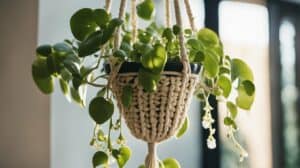The Giant White Bird of Paradise, also known as Strelitzia nicolai, is a stunning plant that can add a tropical touch to any garden or indoor space.
This plant is native to South Africa and is a member of the banana family.
It is known for its large leaves that resemble those of a banana tree and its striking white and blue flowers.

For novice gardeners, the Giant White Bird of Paradise can be a great choice as it is relatively easy to care for.
It prefers well-draining soil and indirect sunlight, making it an ideal indoor plant. However, it can also thrive in full sun if given enough water.
With the right care, this plant can grow up to 30 feet tall and 10 feet wide, making it an impressive addition to any landscape.
In this article, we will explore some growing facts and tips for novice gardeners looking to add the Giant White Bird of Paradise to their collection.
Getting to Know Strelitzia Nicolai
Botanical Profile
Strelitzia Nicolai, commonly known as the Giant White Bird of Paradise, is a stunning tropical plant that belongs to the Strelitziaceae family.
It is native to South Africa and is widely cultivated in many parts of the world due to its attractive foliage and flowers.
The plant is characterized by its large, banana-like leaves that grow in a fan-like pattern and can reach up to 10 feet in height.
The leaves are glossy and dark green, with a waxy texture that helps them retain moisture.
The plant produces stunning flowers that are white and blue in color and resemble the head of a bird.
The flowers are borne on long, sturdy stalks that rise above the foliage and can reach up to 3 feet in height.
The flowers are a favorite of pollinators such as bees and butterflies and can last for several weeks.
Native Habitat and History
Strelitzia Nicolai is native to the coastal regions of South Africa, where it grows in dense, humid forests.
The plant was first discovered in the late 18th century by the British botanist Sir Joseph Banks, who named it after Queen Charlotte of Mecklenburg-Strelitz.
The plant has a rich cultural history and is often associated with tropical landscapes and exotic destinations.
It has been featured in many works of art and literature and is a popular choice for landscaping in tropical and subtropical regions.
In conclusion, Strelitzia Nicolai is a stunning tropical plant that is easy to grow and maintain.
Its attractive foliage and flowers make it a popular choice for landscaping and indoor decoration.
Whether you are a novice gardener or an experienced horticulturist, Strelitzia Nicolai is a plant that is sure to impress.
Cultivation Essentials
Lighting Requirements
The Giant White Bird of Paradise plant requires bright, indirect light to thrive.
Direct sunlight can burn the leaves, so it’s best to place the plant in a spot that receives filtered light or partial shade.
If the plant is not receiving enough light, it may not bloom or grow as well.
Soil Preferences
The Strelitzia nicolai plant prefers well-draining soil that is rich in organic matter.
A mixture of peat moss, perlite, and sand can be used to create an ideal growing medium.
The plant can tolerate slightly acidic to slightly alkaline soil with a pH range of 6.0 to 7.5.
Watering Schedule
The Giant White Bird of Paradise plant should be watered regularly, but not overwatered.
The soil should be allowed to dry out slightly between waterings, but not completely dry. Overwatering can lead to root rot and other problems.
It’s best to water the plant deeply, allowing the water to soak into the soil.
During the growing season, the plant may require more frequent watering.
In summary, the Giant White Bird of Paradise plant requires bright, indirect light, well-draining soil, and regular but not overwatering.
By following these cultivation essentials, novices can successfully grow and care for this beautiful plant.
Plant Care and Maintenance

Fertilizing Guidelines
Giant White Bird of Paradise plants require regular fertilization to thrive and produce healthy foliage.
Novices should fertilize their plant every two to three months during the growing season (spring to fall) using a balanced, water-soluble fertilizer.
It’s important not to over-fertilize as this can cause damage to the plant and hinder growth.
Pruning and Trimming
Pruning and trimming are essential to maintain the health and appearance of the Giant White Bird of Paradise plant.
Novices should remove any dead or yellow leaves as soon as they appear. This will prevent the spread of disease and pests.
Additionally, pruning should be done to remove any old or damaged leaves and stems.
This will encourage new growth and increase the plant’s overall health.
Pest and Disease Management
Giant White Bird of Paradise plants are generally resistant to pests and diseases.
However, novices should still keep a lookout for common issues such as spider mites, scale insects, and leaf spot.
If any pests or diseases are detected, it’s important to treat them as soon as possible to prevent further damage to the plant.
This can be done using organic or chemical treatments, depending on the severity of the issue.
It’s also important to regularly inspect the plant for any signs of stress or damage.
Overall, with proper care and maintenance, the Giant White Bird of Paradise plant can be a stunning addition to any novice gardener’s collection.
Propagation Techniques

The Giant White Bird of Paradise can be propagated by seed or division.
Here are some tips for each method:
Seed Propagation
Seeds should be sown as soon as possible after harvesting, as they lose viability quickly.
They can be sown in a well-draining potting mix and covered with a thin layer of soil.
Keep the soil moist and warm, and germination should occur within 2-3 weeks.
Division Propagation
Division is best done in spring or early summer, when the plant is actively growing.
Carefully separate the clumps of the plant, making sure each division has a good root system.
Replant the divisions in well-draining soil and water thoroughly.
No matter which method is chosen, it is important to keep the soil consistently moist until the plant is established.
Fertilizer can be applied once a month during the growing season to encourage healthy growth.
With proper care, the Giant White Bird of Paradise can be easily propagated and enjoyed in any garden or indoor space.
Frequently Asked Questions
What are the ideal conditions for growing a Giant White Bird of Paradise outdoors?
The Giant White Bird of Paradise plant thrives in warm and humid climates. It prefers well-draining soil and requires ample space to grow.
The plant can tolerate partial shade but prefers full sun exposure.
It’s important to keep the plant protected from strong winds as it can damage its leaves.
How fast does a White Bird of Paradise grow, and how tall can it get?
The growth rate of the White Bird of Paradise plant can vary depending on the growing conditions.
In optimal conditions, the plant can grow up to 30 feet tall. It can take up to 5 years for the plant to reach its full height.
What are the key indoor care tips for a White Bird of Paradise plant?
The White Bird of Paradise plant can be grown indoors, but it requires a lot of space and bright, indirect sunlight.
It’s important to keep the soil moist but not waterlogged. The plant benefits from occasional misting to increase humidity levels.
It’s recommended to fertilize the plant every 2-3 months during the growing season.
Can you provide some interesting trivia about the Strelitzia Nicolai plant?
The Strelitzia Nicolai plant is also known as the “Giant White Bird of Paradise” or “Wild Banana” plant.
It’s native to South Africa and is a member of the banana family. The plant’s flowers are often used in Hawaiian leis.
Is the White Bird of Paradise considered a beginner-friendly plant, and why?
The White Bird of Paradise plant is considered a beginner-friendly plant due to its hardiness and adaptability.
It can tolerate a range of growing conditions and is relatively low-maintenance.
What are the main sunlight and watering requirements for a healthy Strelitzia Nicolai?
The Strelitzia Nicolai plant requires bright, indirect sunlight for optimal growth. It’s important to keep the soil moist but not waterlogged.
The plant benefits from occasional misting to increase humidity levels.
It’s recommended to fertilize the plant every 2-3 months during the growing season.














